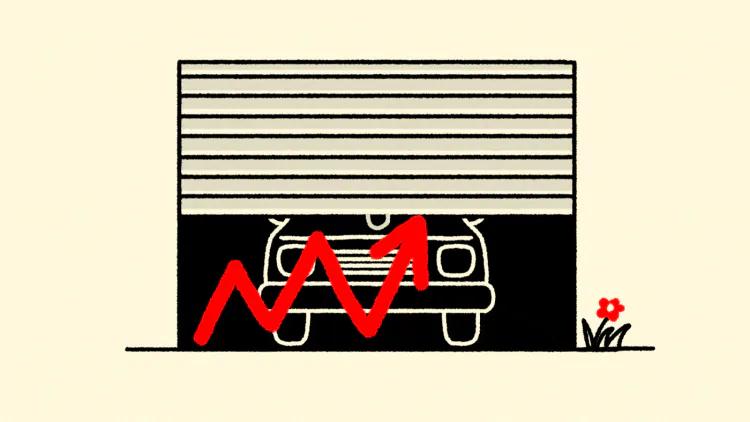The Inflation Nightmare in Your Garage
Why is the cost of car insurance up 40 percent over the past two years?

Inflation, finally, has cooled off. Prices have increased 2.5 percent over the past year, down from increases as high as 7 percent during the early pandemic. Rents are high but stabilizing. The cost of groceries is ticking up, not surging, and some goods, such as eggs, are actually getting cheaper. But American consumers are still stretching to afford one big-ticket item: their cars.
The painful cost of vehicle ownership doesn’t just reflect strong demand driven by low unemployment, pandemic-related supply-chain weirdness, and high interest rates. It reflects how awful cars are for American households and American society as a whole.
Buying a new car is expensive. Prices are actually falling for many makes and models, with plenty of inventory sitting on lots. But that’s only after a huge run-up in sticker prices resulting from semiconductor shortages and other supply-chain snarls earlier in the pandemic. New vehicles remain so expensive that many middle-class families cannot afford them. It’s pretty much only rich families picking them up.
Buying a used car isn’t much better. Costs are declining for many pre-owned vehicles, whether late-model Dodge Rams or ancient Toyota Priuses. Yet prices are still roughly 34 percent higher than they were before the pandemic, having increased 48 percent faster than the overall pace of inflation.
About 80 percent of new-car buyers take out a loan, as do about half of people buying used cars, and financing a car is brutal with interest rates so high. Folks with pristine credit might get a 5.5 percent rate on a new car. Buyers with an average credit score can expect to pay more like 9.7 percent for a pre-owned vehicle. People with bad credit are paying interest rates well into the double digits. Those high rates trap vehicles that might otherwise have hit the resale market in people’s garages—sure, you might get a lot selling your old Kia, but could you afford the payments on a new one? The limited supply, in turn, keeps even pre-owned sticker prices up.
[Christopher Beam: Welcome to pricing hell]
Even if you can afford to buy a car, keeping it maintained is more expensive than ever. Getting a car serviced has gotten pricier and pricier, as today’s highly computerized vehicles have such fussy, complicated parts to check and replace, and as labor shortages and wage pressure hit garages. Finally, there’s auto insurance: The monthly cost of protecting a vehicle has jumped 22 percent over the past year. Insurance costs are up 40 percent over the past two years.
Why are insurance rates so high and climbing so fast? In part due to interest rates: Premiums rise when borrowing costs go up. In part because cars just cost so much right now: Pricey vehicles are pricey to replace in the event of a crash. In part thanks to climate change, which floods and burns people’s garages along with their homes. In part because Americans are driving such enormous, heavy vehicles—four out of five new-car buyers pick an SUV or a truck—that do a lot of damage. Finally, in part because Americans are such awful drivers—episodes of road-raging behavior have increased since the pandemic began, and have become all the more deadly because the cars are so freaking big.
Indeed, the number of traffic fatalities jumped 19 percent from 2019 to 2022, and the fatality rate per mile traveled climbed 22 percent—something Transportation Secretary Pete Buttigieg has described as a “national crisis.” Americans are three times as likely to die in a car crash as citizens of our peer countries. Decades of policy choices prioritizing big, fast roads and car-commuter convenience got us to this point. But why have things gotten so much worse recently? The best working theory I have seen is that the kind of Americans who were out on the roads a lot during the pandemic were the kind of Americans more likely to engage in risky behaviors. With fewer cops and cars out there, they did. And when the cops and cars came back, these Americans kept on driving like maniacs.
As a result of the increased rate of traffic fatalities, some localities have increased fines and fees related to speeding, running red lights, and so on. (Expect that kind of thing to really ramp up if cities and towns begin running into fiscal trouble.) That’s an additional expense for drivers, though arguably one that should go up given the social cost of traffic violence.
Put everything together, and owning a new car is about as expensive as renting a starter studio apartment in a lower-cost city: $12,000 a year. The expense has come to reflect the miserable social cost of America’s obsession with and reliance on private-vehicle ownership. We’re a nation of bad drivers in huge cars traversing roads constructed for volume and speed, our long commutes into our oversubscribed cities making us miserable, our trucks getting damaged by the climate change they helped create. If there’s any upside to the surging prices, maybe it’s that they will force more of us to think that a little investment in public transportation could be a good thing.
What's Your Reaction?




















